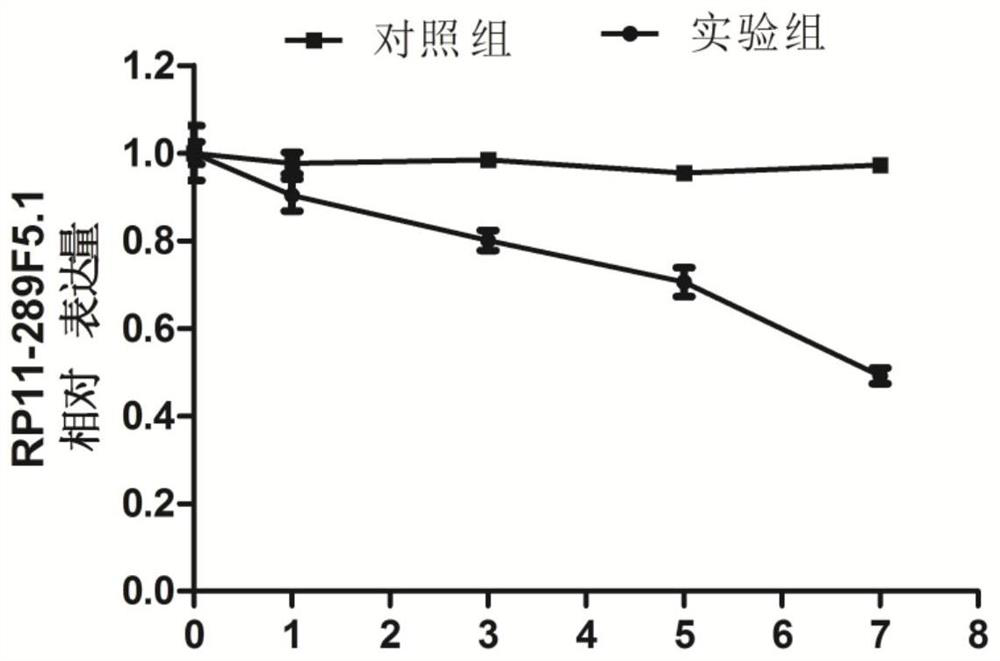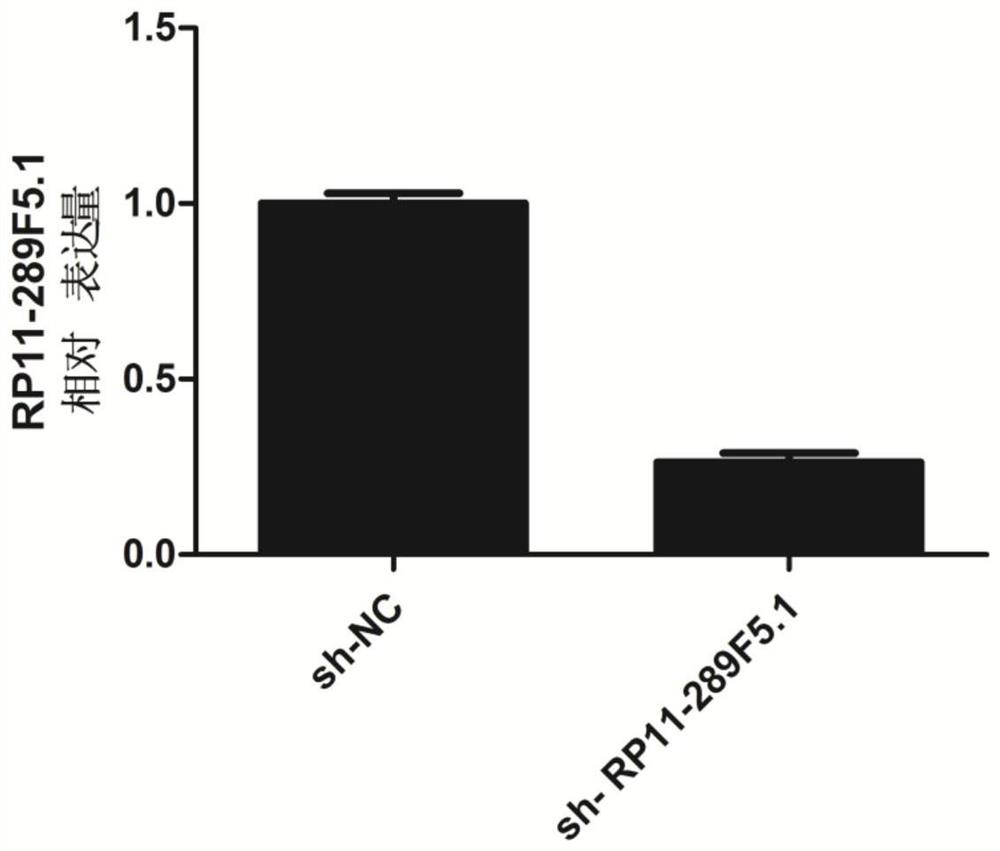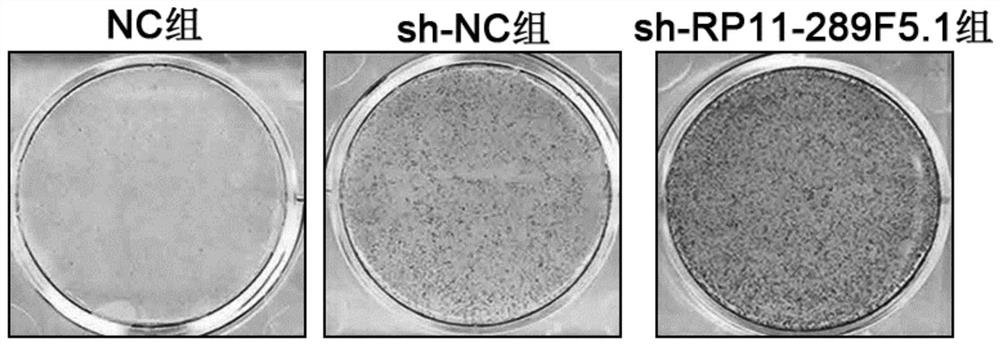Accelerant for proliferation and osteogenic differentiation of periodontal ligament stem cell
A periodontal ligament stem cell and osteogenic differentiation technology, applied in the field of periodontal ligament stem cells, can solve problems such as inability to restore periodontal support tissue, and achieve the effect of promoting osteogenic differentiation and proliferation
- Summary
- Abstract
- Description
- Claims
- Application Information
AI Technical Summary
Problems solved by technology
Method used
Image
Examples
Embodiment 2
[0039] Silencing RP11-289F5.1 promotes ALPase activity in dental pulp stem cells
[0040] Since the expression of RP11-289F5.1 was gradually down-regulated during the osteogenic differentiation of dental pulp stem cells, we speculated that inhibiting the expression of RP11-289F5.1 could effectively promote the osteogenic differentiation of dental pulp stem cells.
[0041] 1. Design sh-RP11-289F5.1 and verify the suppression effect
[0042] (1) Design and synthesize shRNA of RP11-289F5.1, the sequence of sh-RP11-289F5.1 is as follows (the vector used is pENTR™ / U6):
[0043] sh-RP11-289F5.1 sequence Top Strand 5'-CACCGCTGAAGAACGCAATCCAACAGAGATGTTGGATTGCGTTTCTTCAGC-3', SEQ ID NO.6 Bottom Strand 5'-AAAAGCTGAAGAACGCAATCCAACATCTCTGTTGGATTGCGTTTCTTCAGC-3', SEQ ID NO.7
[0044] (2) Use fluorescent quantitative PCR to detect the inhibitory effect of sh-RP11-289F5.1, the experimental results are as follows figure 2 shown. It can be seen from the figure ...
Embodiment 3
[0052] Silencing RP11-289F5.1 to study its effect on the mineralization of periodontal ligament stem cells
[0053](1) The experiment was divided into three groups. The NC group was cultured with complete medium; the sh-NC group was transfected with sh-NC and cultured with osteogenic differentiation medium; the sh-RP11-289F5.1 group was transfected with RP11-289F5 .1 and use osteogenic differentiation medium for culture;
[0054] (2) Culture according to the experimental grouping in step (1). After 21 days of osteogenic differentiation, wash the cells with PBS, rinse the cells twice, and fix the cells with 4% paraformaldehyde for 30 min;
[0055] (3) Discard the fixative, rinse twice with PBS, prepare alizarin red staining solution, add 1.5ml alizarin red staining solution to each well, and incubate at room temperature for 30 minutes in the dark;
[0056] (4) Remove the alizarin red staining solution, rinse twice with deionized water, and take pictures for records.
[0057] ...
Embodiment 4
[0059] (1) The experiment was divided into three groups. The NC group was cultured with complete medium; the sh-NC group was transfected with sh-NC and cultured with osteogenic differentiation medium; the sh-RP11-289F5.1 group was transfected with RP11-289F5 .1 and use osteogenic differentiation medium for culture;
[0060] (2) After 14 days of osteogenic differentiation induction, the culture medium was removed and washed 3 times with PBS;
[0061] (3) Add cell lysate to lyse the cells, collect the lysate into a 1.5ml EP tube, ultrasonically crush and extract protein for 5min, 2s ultrasonication / 3s pause cycle;
[0062] (4) Centrifuge at 12000r / min for 20min at 4°C to collect the precipitate;
[0063] (5) Use the BCA method to measure the protein concentration, and add 5×SDS loading buffer;
[0064] (6) Configure 12% separating gel, load 20ug of sample, stacking gel 80V, 30min, separating gel 120V until bromophenol blue runs to the bottom of the separating gel;
[0065] (7...
PUM
 Login to View More
Login to View More Abstract
Description
Claims
Application Information
 Login to View More
Login to View More - R&D
- Intellectual Property
- Life Sciences
- Materials
- Tech Scout
- Unparalleled Data Quality
- Higher Quality Content
- 60% Fewer Hallucinations
Browse by: Latest US Patents, China's latest patents, Technical Efficacy Thesaurus, Application Domain, Technology Topic, Popular Technical Reports.
© 2025 PatSnap. All rights reserved.Legal|Privacy policy|Modern Slavery Act Transparency Statement|Sitemap|About US| Contact US: help@patsnap.com



